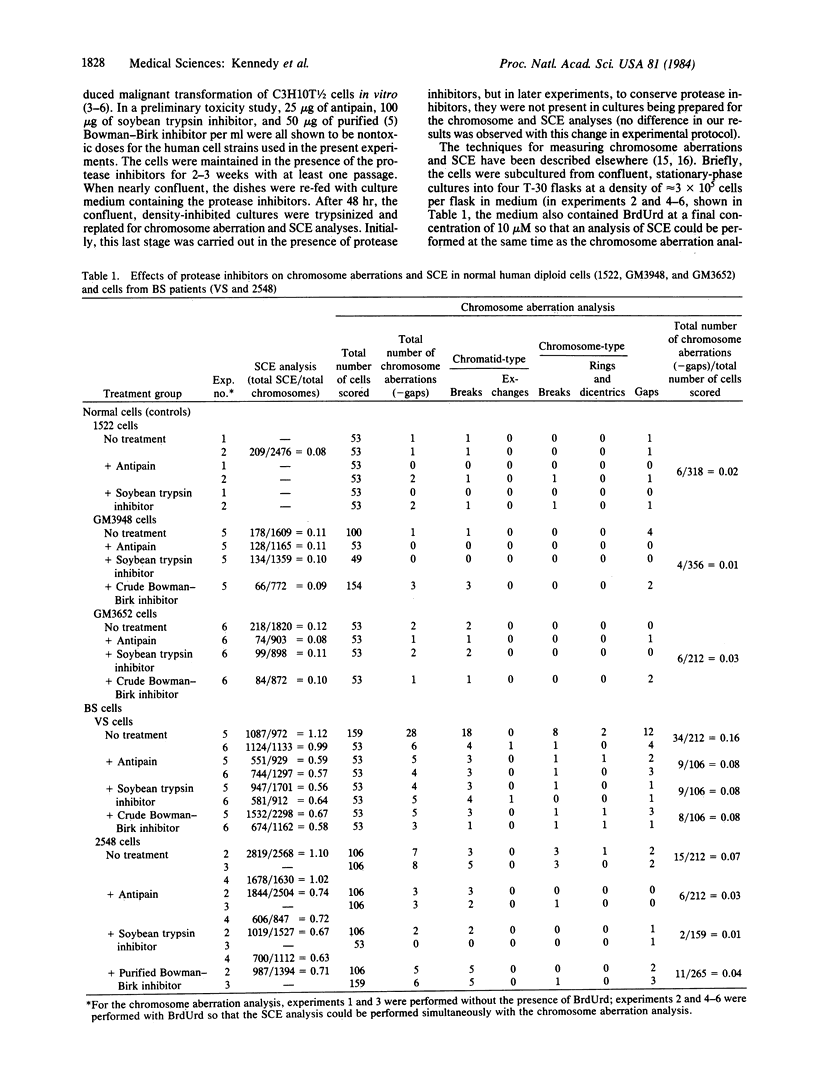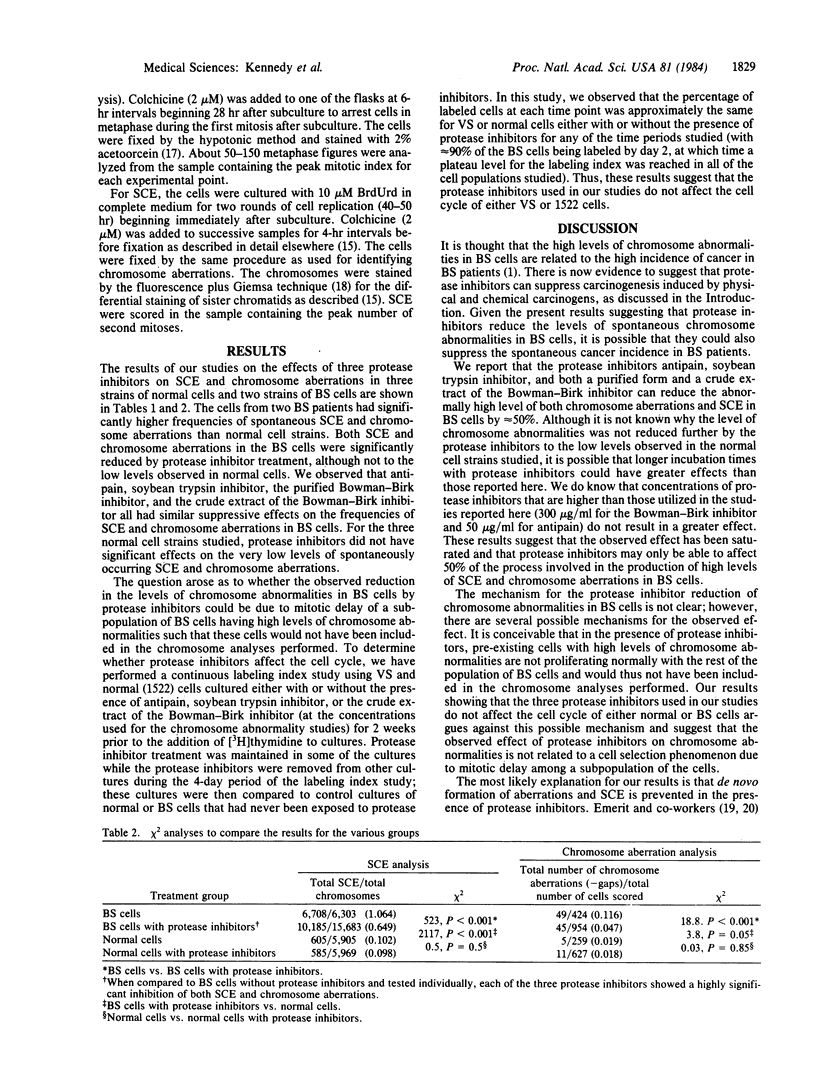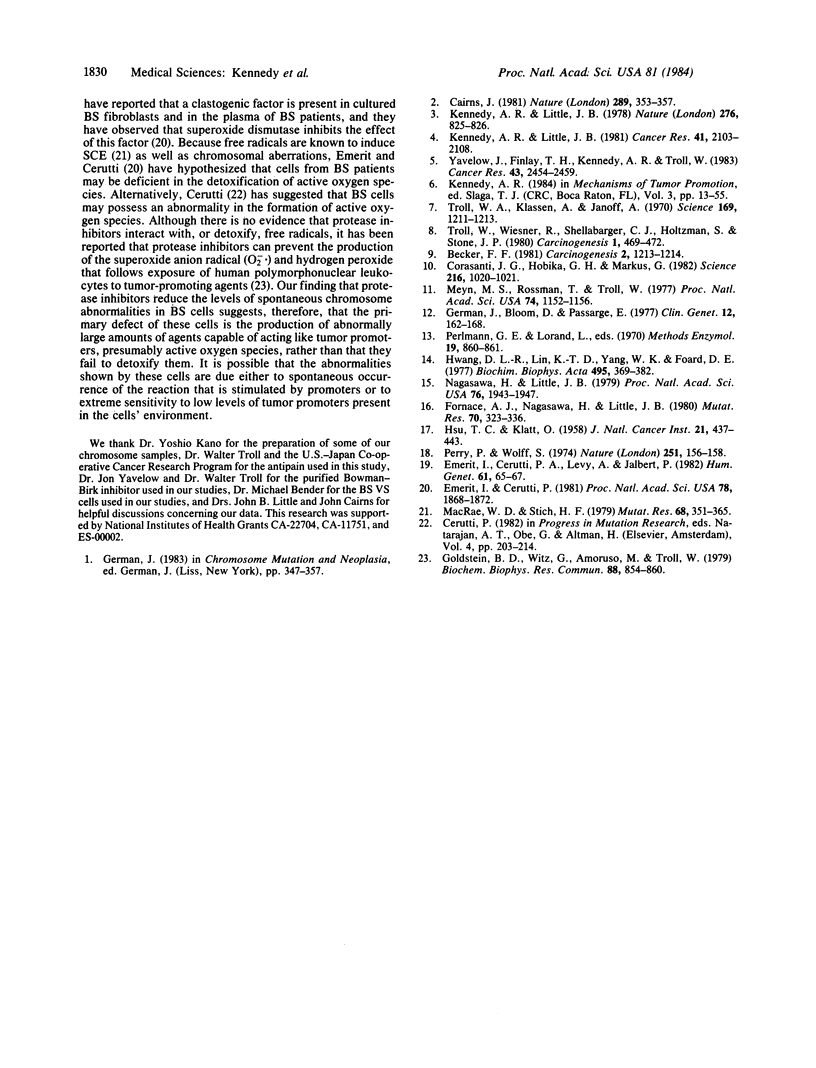Abstract
Bloom syndrome is an autosomal recessive genetic disease. Cells from patients with this disease are characterized by high levels of chromosome aberrations and sister chromatid exchanges. We show here that the frequency of these chromosomal changes is markedly reduced when the cells are grown in the presence of certain protease inhibitors. In relation to other published data, our results suggest that the primary defect of Bloom syndrome cells may be related to the production of abnormally large amounts of agents, presumably active oxygen species, which are capable of acting like tumor promoters.
Full text
PDF



Selected References
These references are in PubMed. This may not be the complete list of references from this article.
- Becker F. F. Inhibition of spontaneous hepatocarcinogenesis in C3H/HeN mice by Edi Pro A, an isolated soy protein. Carcinogenesis. 1981;2(11):1213–1214. doi: 10.1093/carcin/2.11.1213. [DOI] [PubMed] [Google Scholar]
- Cairns J. The origin of human cancers. Nature. 1981 Jan 29;289(5796):353–357. doi: 10.1038/289353a0. [DOI] [PubMed] [Google Scholar]
- Corasanti J. G., Hobika G. H., Markus G. Interference with dimethylhydrazine induction of colon tumors in mice by epsilon-aminocaproic acid. Science. 1982 May 28;216(4549):1020–1021. doi: 10.1126/science.6805074. [DOI] [PubMed] [Google Scholar]
- Emerit I., Cerutti P. A., Levy A., Jalbert P. Chromosome breakage factor in the plasma of two Bloom's syndrome patients. Hum Genet. 1982;61(1):65–67. doi: 10.1007/BF00291336. [DOI] [PubMed] [Google Scholar]
- Emerit I., Cerutti P. Clastogenic activity from Bloom syndrome fibroblast cultures. Proc Natl Acad Sci U S A. 1981 Mar;78(3):1868–1872. doi: 10.1073/pnas.78.3.1868. [DOI] [PMC free article] [PubMed] [Google Scholar]
- Fornace A. J., Jr, Nagasawa H., Little J. B. Relationship of DNA repair to chromosome aberrations, sister-chromatid exchanges and survival during liquid-holding recovery in X-irradiated mammalian cells. Mutat Res. 1980 May;70(3):323–336. doi: 10.1016/0027-5107(80)90022-6. [DOI] [PubMed] [Google Scholar]
- German J., Bloom D., Passarge E. Bloom's syndrome. V. Surveillance for cancer in affected families. Clin Genet. 1977 Sep;12(3):162–168. doi: 10.1111/j.1399-0004.1977.tb00919.x. [DOI] [PubMed] [Google Scholar]
- Goldstein B. D., Witz G., Amoruso M., Troll W. Protease inhibitors antagonize the activation of polymorphonuclear leukocyte oxygen consumption. Biochem Biophys Res Commun. 1979 Jun 13;88(3):854–860. doi: 10.1016/0006-291x(79)91487-6. [DOI] [PubMed] [Google Scholar]
- HSU T. C., KLATT O. Mammalian chromosomes in vitro. IX. On genetic polymorphism in cell populations. J Natl Cancer Inst. 1958 Sep;21(3):437–473. [PubMed] [Google Scholar]
- Hwang D. L., Lin K. T., Yang W. K., Foard D. E. Purification, partial characterization, and immunological relationships of multiple low molecular weight protease inhibitors of soybean. Biochim Biophys Acta. 1977 Dec 20;495(2):369–382. doi: 10.1016/0005-2795(77)90392-0. [DOI] [PubMed] [Google Scholar]
- Kennedy A. R., Little J. B. Effects of protease inhibitors on radiation transformation in vitro. Cancer Res. 1981 Jun;41(6):2103–2108. [PubMed] [Google Scholar]
- Kennedy A. R., Little J. B. Protease inhibitors suppress radiation-induced malignant transformation in vitro. Nature. 1978 Dec 21;276(5690):825–826. doi: 10.1038/276825a0. [DOI] [PubMed] [Google Scholar]
- MacRae W. D., Stich H. F. Induction of sister-chromatid exchanges in Chinese hamster ovary cells by thiol and hydrazine compoudns. Mutat Res. 1979 Dec;68(4):351–365. doi: 10.1016/0165-1218(79)90167-8. [DOI] [PubMed] [Google Scholar]
- Meyn M. S., Rossman T., Troll W. A protease inhibitor blocks SOS functions in Escherichia coli: antipain prevents lambda repressor inactivation, ultraviolet mutagenesis, and filamentous growth. Proc Natl Acad Sci U S A. 1977 Mar;74(3):1152–1156. doi: 10.1073/pnas.74.3.1152. [DOI] [PMC free article] [PubMed] [Google Scholar]
- Nagasawa H., Little J. B. Effect of tumor promoters, protease inhibitors, and repair processes on x-ray-induced sister chromatid exchanges in mouse cells. Proc Natl Acad Sci U S A. 1979 Apr;76(4):1943–1947. doi: 10.1073/pnas.76.4.1943. [DOI] [PMC free article] [PubMed] [Google Scholar]
- Perry P., Wolff S. New Giemsa method for the differential staining of sister chromatids. Nature. 1974 Sep 13;251(5471):156–158. doi: 10.1038/251156a0. [DOI] [PubMed] [Google Scholar]
- Troll W., Klassen A., Janoff A. Tumorigenesis in mouse skin: inhibition by synthetic inhibitors of proteases. Science. 1970 Sep 18;169(3951):1211–1213. doi: 10.1126/science.169.3951.1211. [DOI] [PubMed] [Google Scholar]
- Troll W., Wiesner R., Shellabarger C. J., Holtzman S., Stone J. P. Soybean diet lowers breast tumor incidence in irradiated rats. Carcinogenesis. 1980 Jun;1(6):469–472. doi: 10.1093/carcin/1.6.469. [DOI] [PubMed] [Google Scholar]


